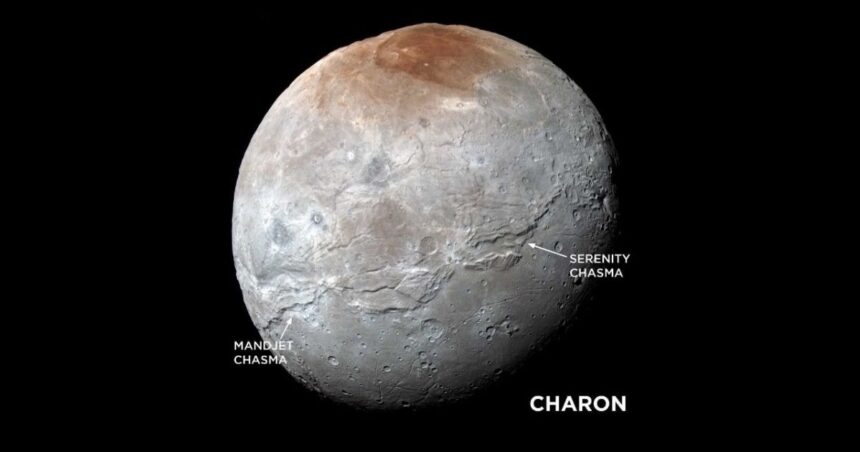Astronomers made a groundbreaking discovery about Pluto’s largest moon, Charon. Using the powerful James Webb Space Telescope (JWST), scientists detected carbon dioxide and hydrogen peroxide on Charon’s icy surface. This discovery could help us understand how Charon and other icy bodies in the outer solar system were formed.
Pluto, a dwarf planet located in the Kuiper Belt, has always fascinated scientists. The size of Charon, its biggest moon, is almost half that of Pluto. Since its discovery in 1978, Charon has been studied extensively. However, previous research was limited because scientists couldn’t explore certain wavelengths of light. This left gaps in our understanding of Charon’s surface composition.
The JWST, launched in December 2021, has changed the game. It can observe the universe in infrared light, which allows it to see things that other telescopes can’t. The team, led by Silvia Protopapa from the Southwest Research Institute (SwRI), used the JWST’s Near-Infrared Spectrograph (NIRSpec) instrument to study Charon.
Their research revealed that Charon’s surface contains carbon dioxide and hydrogen peroxide. These molecules were not detected in previous studies. The presence of carbon dioxide suggests that Charon’s surface has undergone significant changes since its formation. Hydrogen peroxide, on the other hand, indicates that Charon’s surface has been exposed to radiation from the sun.
Charon is a midsized body, roughly 750 miles (1,207 kilometers) wide. It is located in the Kuiper Belt, a ring of icy debris, comets, and dwarf planets at the edge of our solar system. Unlike many larger objects in the Kuiper Belt, Charon’s surface is not covered by volatile ices like methane. This makes it easier for scientists to study the effects of sunlight and cratering on these distant bodies.
The JWST’s findings are significant because they expand our knowledge of Charon’s composition. Before this discovery, scientists knew that Charon’s surface contained water ice, ammonia-bearing species, and organic compounds. The detection of carbon dioxide and hydrogen peroxide adds to this list and provides new insights into Charon’s history.
The presence of carbon dioxide on Charon’s surface is particularly interesting. It suggests that Charon may have experienced volcanic activity in the past. Volcanic eruptions could have released carbon dioxide from the moon’s interior to its surface. This process is similar to what happens on Earth, where volcanic eruptions release gases from the planet’s interior.
Hydrogen peroxide, on the other hand, is formed when water molecules on Charon’s surface are exposed to radiation from the sun. This process, known as irradiation, breaks down water molecules into hydrogen and oxygen. The oxygen then combines with hydrogen to form hydrogen peroxide. This discovery indicates that Charon’s surface has been exposed to radiation for a long time.
The JWST’s findings also have implications for our understanding of other icy bodies in the Kuiper Belt. By studying Charon, scientists can learn more about the processes that shaped these distant objects. This knowledge could help us understand the formation and evolution of the outer solar system.
In addition to its scientific significance, the JWST’s discovery is a testament to the power of modern technology. The telescope’s ability to observe the universe in infrared light has opened up new possibilities for space exploration. It has allowed scientists to see things that were previously invisible, providing new insights into the mysteries of the cosmos.
The discovery of carbon dioxide and hydrogen peroxide on Charon’s surface is just the beginning. As the JWST continues to observe the universe, it will undoubtedly uncover more secrets about Pluto and its moons. These findings will help us piece together the history of our solar system and answer some of the biggest questions about the universe.
Editor’s Recommendations
- Once-in-a-Lifetime Event: Corona Borealis Constellation Shine Brighter as Nova Explosion
- Hubble’s Shocking Discovery, Supermassive Black Hole Jets Trigger Explosive Novas
- Annular Solar Eclipse on Oct. 2, Witness the Sky’s Fiery Ring at Breakneck Speed
- Once-in-a-Lifetime Event: Corona Borealis Constellation Shine Brighter as Nova Explosion




